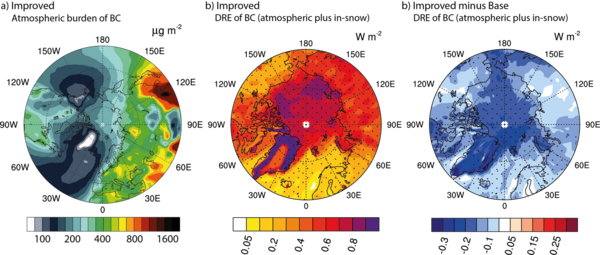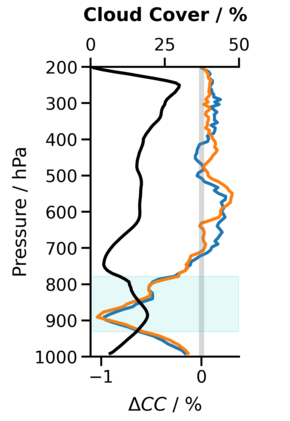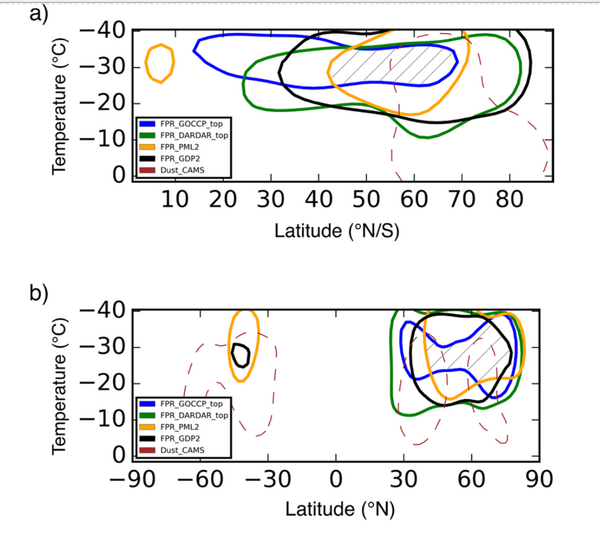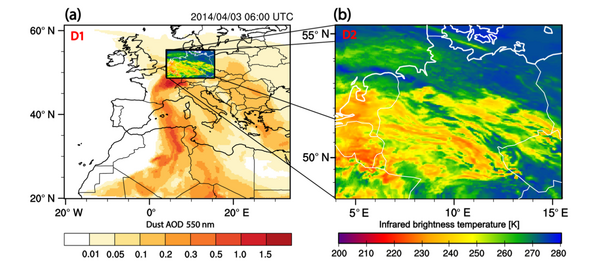Atmospheric aerosol particles directly affect the atmospheric radiation budget by backscattering or absorbing sunlight, as well as semi-directly or indirectly by altering the atmosphere and cloud properties. Effective radiative forcing by aerosol-radiation interactions (ARI) includes both the instantaneous effect and the so-called rapid adjustment of the atmosphere to aerosol effects due to changes in local heating rates caused by aerosol absorption, which can affect atmospheric stability or cloud cover. Furthermore, aerosols have a microphysical influence on the formation of cloud droplets and ice crystals and also contribute to effective radiative forcing in this indirect way via aerosol-cloud interactions (ACI).
Instantaneous aerosol-radiation interactions (direct effects)
In the majority of atmospheric aerosols, light scattering outweighs absorption. In this way, they increase the proportion of sunlight scattered back into space and have a cooling effect on our climate. If the contribution to light absorption increases, the aerosols appear darker, e.g. soot in the smoke aerosol, and more solar radiation is converted into heat within the atmosphere. The instantaneous radiation effect of aerosols is also called the direct effect. Whether the direct aerosol effect results in a positive or negative forcing at the top of the atmosphere is additionally determined by the albedo of the surface below the aerosol layer. If the surface is bright, such as e.g. clouds or snow and ice in the polar regions, absorbing aerosols cause a darkening. In contrast, dark surfaces, such as e.g. the open ocean, are brightened by the scattering effect of aerosols.
For an accurate detection of the direct radiative forcing of aerosols, the distribution, composition and concentration of the aerosols is therefore extremely important, which depends on the detailed knowledge of the emission and transformation processes as well as on atmospheric transport. Our research on instantaneous aerosol-radiation interaction therefore focuses on improving the description of the source, transformation and transport processes for both interesting episodes and long-term analyses (see Fig. 1).

Fig. 1: A revised description of the swelling and conversion processes improves the estimation of the content of black carbon (a) and its radiative forcing (b: absolute radiative forcing, c: change in radiative forcing in relation to the Basis description) in the Arctic.
Fast adjustments to aerosol-radiation interactions (semi-direct effects)

Fig. 2: With the help of high-resolution ICON simulations over Germany with grid spacings of 312 and 625 m, it was established that absorbing aerosol reduces boundary layer cloudiness, liquid water path and precipitation.
Absorbing aerosol plays an important role in the Earth's climate system and contributes to the effects of humans on climate. Absorbing aerosol such as e.g. black carbon in soot absorbs the incident solar radiation and changes the energy content of the atmosphere. This leads to changes in stability in the atmospheric boundary layer and the free troposphere and thus to disturbances in the thermal structure of the atmosphere, which affect cloud formation and cloud development. This effect of absorbing aerosol on clouds is also known as the "semi-direct effect". In the recent literature, the semi-direct effect is considered in a more general perception as part of the rapid adjustments to aerosol-radiation interactions.
Aerosols also reduce downward solar radiation at the surface, which is called surface dimming. On the land surface, this dimming by absorbent aerosols can lead to a significant reduction in the upwelling latent and sensible heat fluxes at the surface. These effects may be large enough over land to cause a significant reduction in cloud cover. Through this mechanism, the dimming of the surface by absorbing aerosol, e.g. due to anthropogenic pollution, can also reduce precipitation and thus can affect on the hydrological cycle. Taken together, the changes in atmospheric stability and the reduction in surface fluxes could cause the cloud fraction, in particular the fraction of boundary layer clouds, to change significantly (see Fig. 2). However, the actual changes depend in a complex way on several factors, including the height of the aerosol layers in relation to the clouds and the type of clouds affected, which is why our research focuses on a fundamental understanding of feedback mechanisms and their interdependence.
Aerosol-cloud interactions (indirect effects)
Clouds interact with atmospheric radiation and change the Earth's energy balance considerably. On the one hand, clouds scatter sunlight back into space and thus prevent the absorption of solar energy and thus warming of the Earth. On the other hand, clouds also retain the heat radiation emitted by the Earth's surface. Both effects usually compensate each other and thus lead to the net cloud radiative effect. On a global average, however, the short-wave effect of clouds (-46 to -48 W m-2) outweighs the long-wave effect (26-28 W m-2) on the radiation budget, resulting in a net cooling effect or in a negative net cloud radiative effect. Since aerosols influence the composition of clouds and thus their radiation properties, aerosol-cloud interactions (indirect effects) change the Earth's energy balance. In addition to the effect of aerosols as a condensation nuclei for cloud droplets, aerosols also influence the formation of cloud ice (heterogeneous ice formation) and other ice microphysical processes, e.g. become important in the formation of precipitation over land. As a crucial component of the hydrological cycle, the effects of aerosols on heterogeneous ice formation are important not only for the Earth's atmosphere but also for the biosphere as a whole.
Our research therefore focuses on the question of how aerosols influence cloud properties, with a special focus on clouds, which are not only made up of cloud droplets. On a global scale, differences between clouds outside the northern and southern hemispheres and between seasons can be used to visualize the effect of atmospheric mineral dust on heterogeneous ice formation (see Fig. 3). Mineral dust, e.g. from the Sahara, is also an important factor for weather and local climate in the Mediterranean and Europe. Temporary dust outbreaks can lead to a considerable increase in the cloud ice content in mid-level mixed-phase clouds as well as cirrus clouds (see Fig. 4).

Fig. 3: Hemispheric (a) and seasonal (b) contrast between the proportion of icy clouds as a function of latitude and cloud temperature. The contours indicate an increased fraction of ice clouds in the northern hemisphere and in the spring - atmospheric conditions in which mineral dust is elevated. Different colors show different measurement methods and their combination.

Fig.4: Atmospheric mineral dust from the Sahara is coming to Europe. Mineral dust (a: optical thickness of the dust) promotes the formation of high and very thick cirrus clouds (b: cirrus is represented by a very cold infrared temperature).




